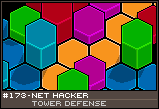|
Mechanic #173 - Net Hacker - Tower Defense |
 | Posted: Jan 08, 2014
Enemies approach on a single data stream. Divert the stream and build defenses to protect yourself. |
|
Tower Defense in Cyberspace |
![[hacker1.png]](set09/img/entry173-hacker1.png)
Fig 173.1 - They're coming to get you, Barbara.
This is a game of competitive tower defense. The computer enemy (in red) will continually send viruses towards the player (in blue). The player can build installations, like defense towers, on the active hexagonal blue grid representing his base. He can also build installations that will create viruses and send them back up the data stream towards the red base.
Initially, there is just the single data stream connecting the two bases. However, the player can divert the data stream between two nodes, splitting it into two parallel streams.
![[hacker2.png]](set09/img/entry173-hacker2.png)
Fig 173.2 - Cyber-goatse.
This is done by selecting a point on the data stream and pulling it towards a node. The stream will split at this point, moving in the exact opposite direction. If you pull the two end points into unoccupied nodes, the single data stream will now become two parallel data streams. Then, you may pull apart those data streams into unoccupied nodes, and so on and so on. After a few splits, the level from the first illustration could look like this:
![[hacker3.png]](set09/img/entry173-hacker3.png)
Fig 173.3 - This time, it's personal.
To build on an unclaimed node, you send a specific kind of virus to it. Once that virus reaches it, it will change the node's color and allow you to build structures on it. The enemy can likewise send specific viruses to opposing nodes to damage it, eventually turning it to unclaimed. Viruses of all types can travel on any data stream, regardless of who owns the particular nodes, so you don't have to claim a node to move through it.
![[hacker4.png]](set09/img/entry173-hacker4.png)
Fig 173.4 - Play. Create. Share.
The nodes themselves are hexagonal grids, with certain cells reserved by the data streams. It is through these pathways that the viruses will travel. On a claimed node, the player can build any number of installations on the unoccupied cells. The one condition is that the installations which directly affect the data stream (see below) must be adjacent to a data stream cell. Similarly, support installations will only support the installations that it directly touches.
Below are a few of the types of installations that can be built:
- Defense Structures - The standard installation of a tower defense game. These installations will attack enemy viruses that pass within range.
- Virus Installation - Will release stored viruses onto the data stream to attack the enemy base. These installations are supported by neighboring buildings, such as ones that build and deliver new virus types, extra storage for larger virus chains, as well as logic installations that can affect the nature of the of how the viruses are released. For instance, one logic support could release viruses when the storage is full, at specific intervals, or even if an enemy just passed nearby.
- Buff Structures - These need to be placed right next to the data stream and will support passing friendly viruses with buffs, like improved strength or speed. Can similarly be improved by placing neighboring support structures.
- Routers - You've built your pathways and started sending friendly viruses against your enemy. Routers can manipulate the paths taken by viruses, both friend and foe. For instance, you can create a router that will alternate between two paths, breaking your enemy chains up into two smaller ones. Or a router which will send you attack viruses down one path, but your support viruses up the other.
- Gates - A defensive structure which prevents certain types of viruses from passing through. For instance, it can let through only attack or only support viruses, or only viruses shaped like a plus. The viruses that it keeps out will eventually destroy the gates, if not paired with defense structures nearby. Also, gates work both ways, when it keeps out attack viruses, it keeps out all attack viruses, both good and bad. Pair it with a logic gate to turn it off when friendly viruses are nearby.
- This idea originated from another idea that has not yet made it into the Three Hundred, called Net Hacker Nodes. It'll show up sooner or later, but the basic premise was that you took over servers by building small gridded nodes that allowed you to build things inside the level. I took the node idea and figured I could use it to make a tower defense idea.
- Originally, the nodes and data streams were prebuilt, and it was a more traditional Tower Defense type game. I thought it would be interesting to have a large, almost open world where you could see the enemies arriving from far away. In addition to that, you would build slowly towards it, as you collected resources.
- I toyed with the idea of building your own nodes, but end up with situations where viruses wouldn't travel down extraneous nodes or else they could get stuck at a dead end. So I figured that if I was going to build new nodes, I needed to make sure that none of them were dead ends. Splitting apart an existing line into two parallel lines seemed like an obvious way to make sure all nodes were connected to both bases in a linear fashion. |